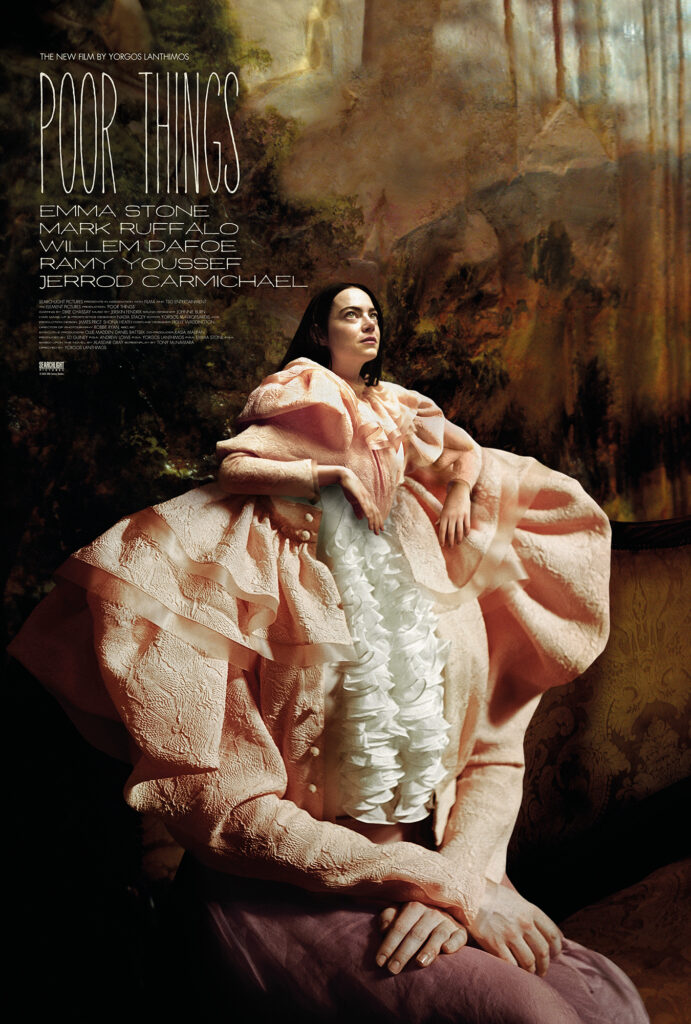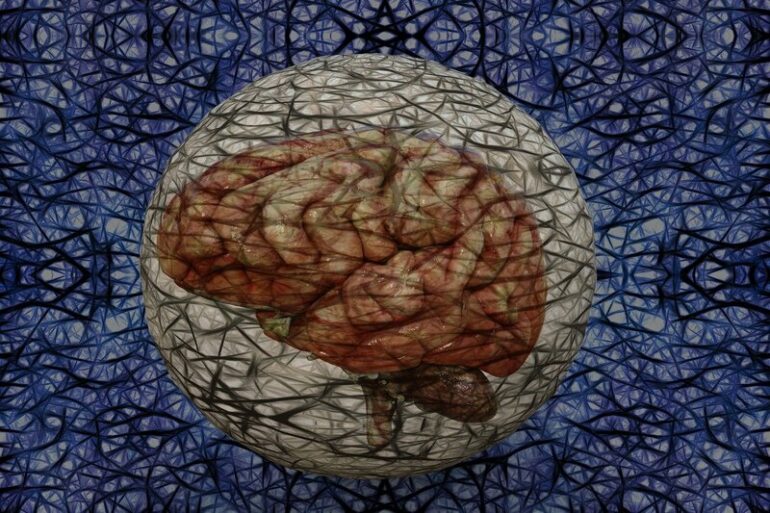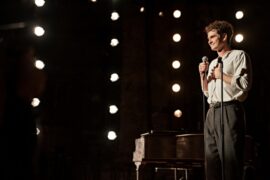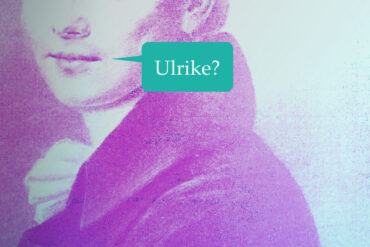Yorgos Lanthimos’s Poor Things is a visually arresting exploration of identity, societal constraints, and parent-child relationships, throughthe unique journey of Bella Baxter, a woman reborn via brain transplant. With allusions to literary works and a distinctive aesthetic, the film challenges viewers to reconsider normalcy and the possibility of change.
Von Cemal Can Özmumcu
Yorgos Lanthimos’s provocative adaptation of Alasdair Gray’s 1992 novel Poor Things delivers a uniquely unsettling and visually arresting cinematic experience. The film follows the tumultuous life of Bella Baxter (Emma Stone), a young woman brought back from the dead by the eccentric Dr. Godwin Baxter (Willem Dafoe) via a brain transplant.
In its exploration of identity and societal constraints, the film consistently echoes the question, »Who are the poor things?«, suggesting that each character, not just Bella, grapples with their own form of suffering and isolation. But Bella, as a manufactured being, occupies a liminal space between the traditional appearance of adulthood and the fast-growing mind of a child. Her patchwork existence renders her the ultimate outsider in an already stifling society. Bella’s behavior and speech further set her apart; she often exhibits a naive curiosity and innocence that contrast sharply with the more cynical and experienced adults around her. Her mannerisms and speech patterns, shaped by how quickly her mind grows, make her noticeably different from others. Still, Lanthimos extends this notion of social hardship to the other characters. Bella’s passionate lovers, Duncan Wedderburn (Mark Ruffalo) and Alfie Blessington (Christopher Abbott) find themselves trapped by their own rigid masculinity. Both Duncan and Alfie, despite their attraction to Bella’s free spirit, ultimately seek to confine her within their own limited and traditional expectations of womanhood. Dr. Baxter’s intellectual pursuit of creation leaves him emotionally isolated. Unlike her lovers, Bella evolves with each encounter, embodying the fluidity of identity against the backdrop of a society marked by rigidity and stagnation. Each character becomes a »poor thing« in their refusal or inability to change, mirroring the complex facets of human nature.
Hamlet and Ophelia in Victoria
Godwin Baxter, while explaining Bella’s (Victoria’s) past, says: »I knew nothing of the life she had abandoned, except she hated it so much that she had chosen not to be.« In a movie brimming with high language and meticulous word choice, it is only natural that »not to be« is a reference to Hamlet. It mirrors Ophelia’s tragic fate, who, overwhelmed by grief and madness, ultimately drowns herself. Both women find themselves caught in the throes of an unbearable existence, which leads them to seek a final release in water. Additionally, the oppressive bonds of Bella’s previous marriage are revealed later in the film, echoing the tumultuous relationship of Ophelia and Hamlet. Ironically, the sentence connects her to both Ophelia’s tragic fate and Hamlet’s existential crisis. These reflections underscore the weight of Godwin’s words in unraveling Bella’s profound struggles.
Because Bella is two different people in the same body, it is important to distinguish between her past and her present. In her past, she carried the brain of her mother, Victoria. Whereas Victoria possessed the tragic fate of Shakespearean figures, Bella knows how to amuse herself and has a hope for the world. This transformation underlines the movie’s exploration of rebirth and the possibility of change. Bella’s own words reflect this optimism: »We are all on a ship and cannot escape, and there is a world to enjoy, traverse, circumnavigate«. With this philosophy, she sets herself apart as a beacon of hope amidst the »poor things« of the world.
Parents and Children
At first glance, the idea that Bella is her own child seems unbelievable. But every biological child, to some extent, bears a resemblance to its parents, both in appearance and learned behaviors. It is as if Lanthimos is challenging the audience: »Does absurdity lie in the literalness of this concept, or is it merely a heightened reflection of reality?« The fact that Bella’s past self is literally her mother adds a layer of complexity to this exploration of inherited patterns. After all, our history is intrinsically shaped by those who has come before us, and without conscious self-examination, we risk repeating the same cycles. In a darkly ironic twist, when Bella runs away with Alfie Blessington (Victoria’s husband, Bella’s father) towards the end, she nearly finds herself trapped within the same constraints that victimized her mother. While trying to escape, don’t all of us somehow find ourselves in the shoes of our parents? Maybe yes, but here, Bella makes her biological father (Alfie Blessington) literally shoot himself in that shoe, and does not confine herself to the same fate. Poor Things seems to suggest that while the past may always linger, true freedom lies in conscious choice.

Poor Things
Directed by Yorgos Lanthimos.
Screenplay by Tony McNamara
Based on Poor Things by Alasdair Gray
Produced by
Ed Guiney, Andrew Lowe, Yorgos Lanthimos, Emma Stone.
Starring
Emma Stone, Mark Ruffalo, Willem Dafoe, Ramy Youssef, Christopher Abbott, Jerrod Carmichael.
The film dissects the complexities of parent-child relationships, examining how their influence can be both formative and destructive. The very name of Bella’s creator, »Godwin,« carries a hint of irony, suggesting the desire of parental figures to exert ultimate control over their children’s lives. This power dynamic is reinforced by several visual choices. The disproportionately large chairs occupied by both Godwin and Alfie highlight the authority they attempt to wield over Bella. Additionally, the film’s lighting design further emphasizes this dynamic. Scenes featuring Godwin and Alfie often employ high-contrast lighting, casting deep shadows that create a foreboding atmosphere, underscoring the nature of their control and the uncertainty of Bella’s situation. In contrast, Bella herself is frequently depicted in softer light, emphasizing her vulnerability within this oppressive environment. Furthermore, Godwin’s own troubled history with his abusive father reveals that even those seemingly in positions of power are often shaped by the negative patterns of those who came before them.
Extraordinary within the Ordinary
In one particularly striking scene from Poor Things, one sees the protagonists riding in a motorized carriage, the front of which is adorned with a plastic horse’s head. This contrasts sharply with the surrounding carriages, which are traditionally horse-drawn. This oddity is not merely a quirky visual choice, but a deliberate statement that encapsulates the film’s blending of culture and nature into a single, cohesive yet fragmented entity. The motorized carriage with its artificial horse head serves as a metaphor for the patchwork nature of Bella’ existence and the broader narrative—a seamless integration of the natural and the constructed, the organic and the synthetic.
By standing out in its peculiarity, the carriage underscores the film’s themes of identity and transformation, emphasizing the unique and disjointed journey of its characters amidst a seemingly conventional backdrop. This moment encapsulates the essence of Poor Things, where the extraordinary is nestled within the ordinary, urging viewers to reconsider their perceptions of normalcy and reality.
Through the Fisheye
Poor Things stands out for its distinctive visual language and score. The film’s unique aesthetic—marked by surreal colors, unsettling music, and innovative use of fisheye lenses—transports the audience into a world that feels simultaneously otherworldly and distorted. This visual distortion feels reminiscent of Lewis Carroll’s Alice in Wonderland, subtly suggesting Bella’s displacement in a world she doesn’t quite fit. Yet, there is no overt reliance on familiar Alice imagery. Similarly, the film alludes to Mary Shelley’s Frankenstein with its central premise of reanimation, but avoids obvious literal references, allowing the work to stand on its own. The score further amplifies this unsettling atmosphere, a composition that is both unique and deeply unnerving.
Yorgos Lanthimos’s signature style is evident in Poor Things. The confined settings, domineering paternal figures, and characters desperate for companionship are reminiscent of his earlier works, such as Dogtooth and The Lobster. This thematic continuity positions Poor Things as a worthy addition to Lanthimos’s filmography. Moreover, the language of Poor Things is another area in which the film distinguishes itself. Every line delivered carries the weight of poetry, emphasizing that Poor Things is not an exercise in realism, but rather an exploration of complex themes through an expressionist lens. This choice underscores the film’s thematic exploration of life’s inherent complexity, with each word serving as a deliberate stroke in the broader picture it paints of human existence.
In Poor Things, Yorgos Lanthimos has crafted a film that is as unsettling as it is visually arresting. The narrative’s exploration of identity, social constraints, and the complexities of parent-child relationships are presented through a distinctive visual and auditory aesthetic that sets it apart. Emma Stone’s portrayal of Bella Baxter, a character caught between past and present identities, is both poignant and transformative, embodying the film’s central themes of rebirth and the possibility of change. As viewers are drawn into this world of constructed realities and distorted perceptions, Poor Things challenges them to reconsider their own notions of normalcy and human nature. Lanthimos’s film is a masterful blend of the extraordinary within the ordinary, a cinematic experience that lingers long after the avant-garde credits roll.






